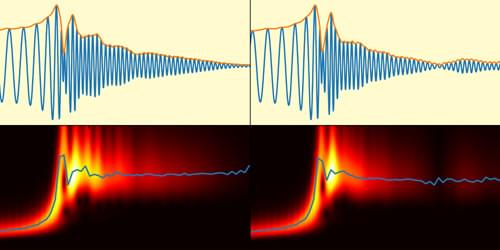Simulations indicate that postmerger gravitational waves from coalescing neutron stars could allow researchers to hear the phase transitions between exotic states of matter.
Linking acoustic and seismic signals from meteorite strikes to orbiter images is a step toward mapping the planet’s interior.
“Dirt” Is No Barrier to Flocking
Posted in futurism
Predictions indicate that disorder induced by immobile imperfections does not prevent organisms from moving collectively as a group.
Improved fabrication methods for qubits made from erbium-doped silicon waveguides give these qubits the key prerequisites for becoming a contender for future quantum computers.
From superconducting circuits to single atoms, there are many quantum-bit—or “qubit”—systems to choose from when building a quantum computer. New to the game are qubits made from individual erbium atoms implanted in silicon waveguides. Each of these qubits can be controlled and measured with telecom-wavelength light, making the platform practical to implement. But the platform has unfavorable properties that have put that implementation on hold. Now Andreas Reiserer of the Max Planck Institute of Quantum Optics in Germany and his colleagues have improved the qubit’s fabrication and detection methods, such that it is viable for near-future use in quantum computing technologies [1]. The results suggest that erbium-doped silicon waveguides could make more promising qubits than previously thought.
One problem with previous erbium-doped silicon waveguides came from the uneven clustering of erbium atoms around impurities in the waveguide. This clustering meant that the erbium atoms had different transition frequencies, making it difficult to simultaneously address multiple atoms and to perform basic operations between them—a necessary component of quantum information processing.
“Dicamba drift”—the movement of the herbicide dicamba off crops through the atmosphere—can result in unintentional damage to neighboring plants. To prevent dicamba drift, other chemicals, typically amines, are mixed with dicamba to “lock” it in place and prevent it from volatilizing, or turning into a vapor that more easily moves in the atmosphere.
Now, new research from the lab of Kimberly Parker, an assistant professor of energy, environmental and chemical engineering at Washington University in St. Louis’ McKelvey School of Engineering, has shed new light on this story by demonstrating for the first time that these amines themselves volatilize, often more than dicamba itself.
Their findings were published Sept. 23 in the journal Environmental Science and Technology.
When a volcanic eruption occurs in an inhabited area, rapid and accurate lava flow forecasts can save lives and reduce infrastructure and property losses. To ensure that current lava forecasting models can provide outputs fast enough to be useful in practice, they unfortunately must incorporate physical simplifications that limit their accuracy.
To aid evacuation plans, forecast models must predict a lava flow’s speed, direction, and extent. These attributes are intimately connected to how the lava solidifies as it cools. Yet to achieve real-time speed, most current models assume that a flow has a uniform temperature. This is a major simplification that directly influences modeled rates of cooling; generally, lava flows are much cooler at their boundaries, where they are in contact with air or the ground, than they are internally.
Aiming to strike a better compromise between speed and realism, David Hyman and a team developed a 2D, physics-based lava flow model called Lava2d. They extended the traditional, vertically averaged treatment of a lava packet by considering it as three distinct regions: the portion near the lava-air boundary, the portion near the lava-ground boundary, and the fluidlike central core. The top and bottom regions of a modeled flow cool based on the physics of heat transfer to the air and ground, while the temperature in the center remains uniform, as in prior approaches. This setup enables the model to account for a temperature gradient without requiring a computationally expensive 3D approach.
The finding is a turning point in cancer research.
Two major studies published in Nature.
Phospho Biomedical Animation.
The revelation shows that epigenetics, cells controlling gene activity, play a crucial role in the development of cancer. Cancers are usually tested for DNA mutations alone, which can miss this level of control, thereby failing to predict how cancers may behave and respond to treatment.
This harkens back to the first time he spoke about Twitter as a town square.
Elon Musk, CEO of Tesla, has now confirmed he is buying Twitter. The billionaire has tweeted a letter of sorts addressed to the advertisers who use Twitter. In the letter, Musk explains why he bought Twitter and that most of the speculation surrounding the purchase has been wrong.
Twitter is important to civilization
In the letter, which is separated into three parts, each a tweet, he starts off by saying right away that he feels Twitter is important to civilization because it provides a “town square” where a wide range of beliefs can debated in a healthy manner, without resorting to violence. This sentiment has been a staple of Musk’s feelings about the social media platform, as he has stated before in interviews.
It’s going to get even worse, says the CEO in the earnings call.
Mark Zuckerberg’s dream of building the future of the internet is costing Meta billions of dollars every quarter. In the quarterly earnings call on Wednesday, Reality Labs, Meta’s division tasked with building the metaverse, reported a loss of $3.67 billion in the period between July through September, up from $2.8 billion in the previous quarter, Engadget.
IStock/COM & O
What is making it the talk of the town is the fact that Meta is spending billions every quarter and has raked up losses close to $20 billion since the rebrand. This is especially worrying for the company’s investors, who expect the economy to take a downturn soon and are wondering when the madness at Meta will stop.
In the ongoing work to realize the full potential of quantum computing, scientists could perhaps try peering into our own brains to see what’s possible: A new study suggests that the brain actually has a lot in common with a quantum computer.








